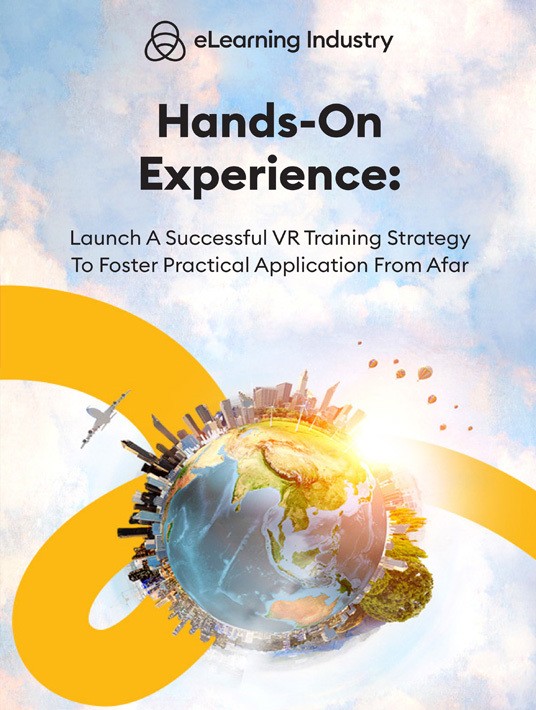
8 Tips To Choose The Best Virtual Reality Training Software For Your Budget
How To Choose The Best VR Training Software Within Your Budget
VR software helps you create immersive 3D training environments for your team; safe spaces that facilitate hands-on training from a distance. In other words, it’s a dream come true for companies that want to build experiential knowledge during the COVID-19 crisis. You can also use VR training systems to provide remote training long after we’ve overcome the curve. While some outsourcing partners already have an established toolbox, others allow you to choose platforms for your project. Even if you outsource your VR training programs, it’s always good to have eLearning authoring tools on hand just in case you need to make some minor changes or update VR activities in the future.

eBook Release
Hands-On Experience: Launch A Successful VR Training Strategy To Foster Practical Application From Afar
Let’s explore how you can implement successful VR training strategies for experiential learning!
8 Top Tips To Choose The Best VR Training Software For Your Budget
1. Clarify Your Software Spending Limit
Every organization has a VR training budget. But you should develop a separate expense sheet for software. Include setup costs, monthly subscriptions, and ongoing maintenance, as well as payroll for all the above. For example, it will take a week for your team to install the VR software and get over the learning curve. Once you have a clear budget, set a max spending limit. Try to leave some wiggle room for unexpected fees like add-ons or advanced support services.
2. Survey Your Team To Identify Their Must-Have Features
Is your team comfortable with VR training software? Or are they new to the world of interactive design tools? Evaluate your team to gauge their level of tech-savviness, as well as narrow the list of must-have features. Which functions do they need to develop immersive content that captivates your audience? First and foremost, you need a platform that’s user-friendly and intuitive. Then you can move on to other essential features. For example, video editing, collaborative tools, and multimedia assets.
3. Evaluate Support Services
Most software vendors provide support services, ranging from online demos to live chats. But how responsive are they, really? Does it take them a week to respond to emails? Has their online user forum been dormant for months? Test out their support before making your final decision. You can also contact them with a question to see how quickly they reply and if they address your concerns. For instance, they might answer within an hour but it’s a template response. Another option is to visit their social media to see how (or if) they interact with the public. Do they respond to comments, even if it’s constructive criticism? When was the last time they made a post? Are they active on several platforms?
4. Read Online Reviews
Social proof and reviews aren’t necessarily deal-breakers. However, they do give you the chance to evaluate VR training software from the other side. Namely, from the perspective of someone who’s already created VR content and understands the tool’s limitations. Reviews can also shed light on the product’s real-world benefits and functionality. Look for sponsor-free review sites that feature the pros, cons, and detailed performance overviews.
5. Take A Test Drive
The only thing better than reading reviews is to explore the product’s features firsthand. Many VR training tool vendors offer free trials or demos, which allows you to develop sample projects and evaluate the user interface. In fact, invite the whole team for a test drive. Then collect their feedback to choose a clear winner. However, you should develop evaluation criteria so that everyone knows what to look for.
6. Analyze Their Asset Library
Most VR software solutions have built-in assets, including templates, themes, interactions, and cut-out characters. As such, the repository should be a main focal point during the free trial. See what the software has to offer and if the media suits your needs. For example, there are thousands of assets but none that fit into your compliance safety simulation. And it’s not just about quantity. The quality of the assets counts, too; low resolution is a major red flag.
7. Submit RFPs
Until now, you’ve been covertly qualifying vendors. Sure, you had to provide some basic info for the free trial. But they still don’t know about your training requirements or spending cap. So, submit RFPs to your top contenders for personalized quotes and spec sheets. Vendors reply with proposals so that you can compare their features side by side. When necessary, schedule a follow-up meeting to discuss your concerns and additional buying needs. Just be sure to prepare a list of questions beforehand to respect everyone’s time.
8. Assess Your VR Training Vendor’s Toolbox
If you’re outsourcing VR training development, ask the company about their tools of choice. Firstly, they can offer recommendations based on their past experiences. Secondly, you know that your new tool is compatible with theirs. For example, the delivery formats are the same. The primary reason to purchase VR training platforms when outsourcing is to maintain content. Thus, you may want to purchase their preferred tool, especially if the outsourcing partner gives it high marks.
Conclusion
There isn’t a one-size-fits-all VR training software that suits everyone’s needs because every organization has its own spending cap, team talents, and training requirements. However, this guide can help you find a VR design platform that lives up to expectations. Start with a clear budget and skills assessment, then move on to vendor qualification. Your top software contenders should have personalized support and a solid online reputation. Last but not least, make sure the new system plays well with others; namely, your outsourcing partners’ toolbox.
Are you ready to partner up with a virtual reality training pro who can help you stretch available resources? Our exclusive online directory has the top vendors for every industry. There’s even a complete solutions list so that you can find a company that delivers the total package.
Download the eBook Hands-On Experience: Launch A Successful VR Training Strategy To Foster Practical Application From Afar for insider tips to launch an experiential learning program.

Homebase
Make work easier. Running a small business has never been harder. Homebase helps with free tools to track time and manage your team.
Stay connected with us on social media platform for instant update click here to join our Twitter, & Facebook
We are now on Telegram. Click here to join our channel (@TechiUpdate) and stay updated with the latest Technology headlines.
For all the latest Education News Click Here
For the latest news and updates, follow us on Google News.

